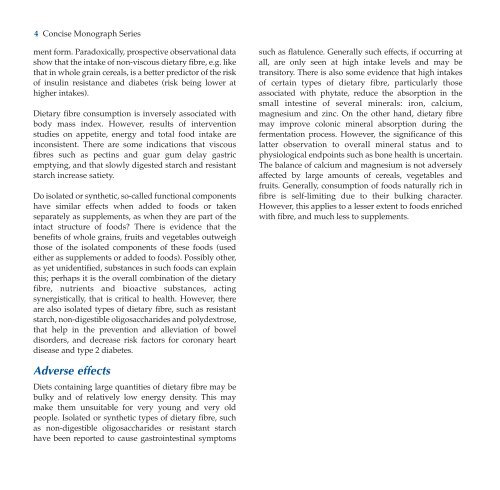Dietary Fibre - ILSI Argentina
Dietary Fibre - ILSI Argentina
Dietary Fibre - ILSI Argentina
Create successful ePaper yourself
Turn your PDF publications into a flip-book with our unique Google optimized e-Paper software.
4 Concise Monograph Series<br />
ment form. Paradoxically, prospective observational data<br />
show that the intake of non-viscous dietary fibre, e.g. like<br />
that in whole grain cereals, is a better predictor of the risk<br />
of insulin resistance and diabetes (risk being lower at<br />
higher intakes).<br />
<strong>Dietary</strong> fibre consumption is inversely associated with<br />
body mass index. However, results of intervention<br />
studies on appetite, energy and total food intake are<br />
inconsistent. There are some indications that viscous<br />
fibres such as pectins and guar gum delay gastric<br />
emptying, and that slowly digested starch and resistant<br />
starch increase satiety.<br />
Do isolated or synthetic, so-called functional components<br />
have similar effects when added to foods or taken<br />
separately as supplements, as when they are part of the<br />
intact structure of foods? There is evidence that the<br />
benefits of whole grains, fruits and vegetables outweigh<br />
those of the isolated components of these foods (used<br />
either as supplements or added to foods). Possibly other,<br />
as yet unidentified, substances in such foods can explain<br />
this; perhaps it is the overall combination of the dietary<br />
fibre, nutrients and bioactive substances, acting<br />
synergistically, that is critical to health. However, there<br />
are also isolated types of dietary fibre, such as resistant<br />
starch, non-digestible oligosaccharides and polydextrose,<br />
that help in the prevention and alleviation of bowel<br />
disorders, and decrease risk factors for coronary heart<br />
disease and type 2 diabetes.<br />
such as flatulence. Generally such effects, if occurring at<br />
all, are only seen at high intake levels and may be<br />
transitory. There is also some evidence that high intakes<br />
of certain types of dietary fibre, particularly those<br />
associated with phytate, reduce the absorption in the<br />
small intestine of several minerals: iron, calcium,<br />
magnesium and zinc. On the other hand, dietary fibre<br />
may improve colonic mineral absorption during the<br />
fermentation process. However, the significance of this<br />
latter observation to overall mineral status and to<br />
physiological endpoints such as bone health is uncertain.<br />
The balance of calcium and magnesium is not adversely<br />
affected by large amounts of cereals, vegetables and<br />
fruits. Generally, consumption of foods naturally rich in<br />
fibre is self-limiting due to their bulking character.<br />
However, this applies to a lesser extent to foods enriched<br />
with fibre, and much less to supplements.<br />
Adverse effects<br />
Diets containing large quantities of dietary fibre may be<br />
bulky and of relatively low energy density. This may<br />
make them unsuitable for very young and very old<br />
people. Isolated or synthetic types of dietary fibre, such<br />
as non-digestible oligosaccharides or resistant starch<br />
have been reported to cause gastrointestinal symptoms

















